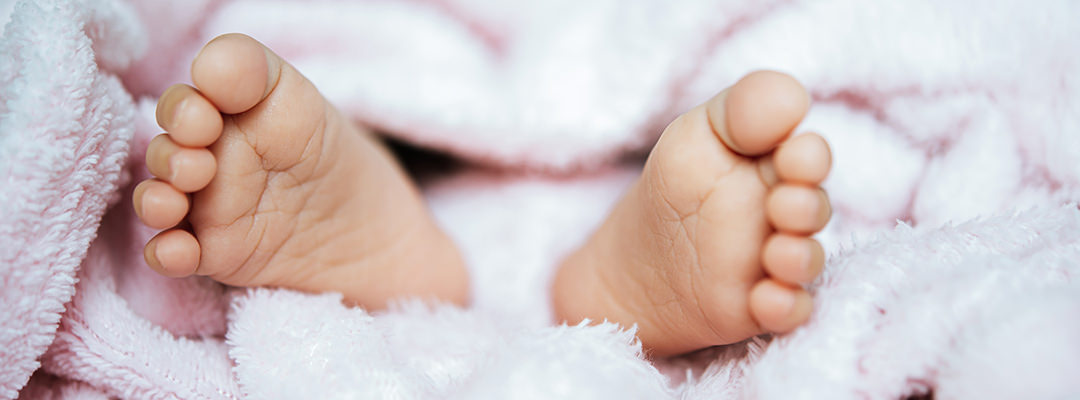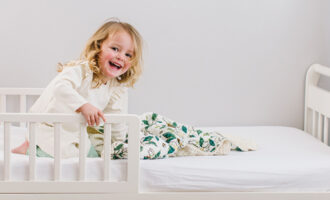When you think of cute, snuggly, photo-op moments with your newborn, one of the first things that comes to mind is probably an uber-soft cozy blanket in instagrammable pastels. In fact, many of us might have photos of our own little selves curled up with our favorite blanket.
That’s why it might surprise you to know that experts are suggesting that letting a newborn baby sleep with a blanket is actually inadvisable for the baby’s health, and possibly very dangerous, including accidental suffocation. Pediatricians recommend that newborn babies sleep wrapped up in swaddle blankets before switching to blankets as they get a little bit older.
So what’s the problem with baby blankets? How can anything so adorably comfortable ever be threatening? Let’s look at why they can be such a cause for concern for new parents.
Are Blankets Safe For My Baby?
The thing you gotta remember about babies is that, unlike fully formed adult humans, they’re still figuring out how the world works in a major way. They’re also still figuring out how their bodies work. The way they coordinate what they experience with how they react isn’t quite all the way there yet.
Blankets, especially weighted blankets, as well as other loose soft items such as pillows and plush toys, can be dangerous to very small babies because they can block airflow to the baby’s nose and mouth. If the child begins to turn over or pulls the blanket up near their face, they might not understand how to move it away again. This is what leads to Sudden Infant Death Syndrome, or SIDS.
What Is SIDS?
SIDS — Sudden Infant Death Syndrome, sometimes also called “cot death” — is the unexpected death of a healthy baby under one-year-old. In the UK, this is believed to affect 200 infants each year. Given the number of children that are born each year that’s a pretty low number, but as a new parent, you still want to be as careful as you can.
Sudden Infant Death Syndrome can be caused by a few different things, but it all basically comes down to the child’s body giving out because it can’t deal with some environmental stress. Breathing obstructions — including those caused by tobacco smoke, minor illnesses, and obstruction to air passageways — are a major player. Babies can’t handle these things the way that we can, which is why it’s so important to make sure your child always has access to safe, clean air.
How Do I Keep My Baby Safe While They’re Snoozing?
To help remind parents how to keep their babies safe, the American Association of Pediatrics came up with the “ABCs of safe sleep”: Alone on their Back in a Crib.
Alone means that while you should always try to be nearby when your baby is sleeping, you never want to have them right in the bed with you. It also means making sure that there’s no flotsam in their crib along with them, including blankets, pillows, and toys.
Back is the safest way for a newborn baby to sleep; they have lots of air in front of and around both sides of their head. They have a little bit of flexibility of movement to look around, but they’re not in danger of burying their little selves underneath their arms or shoulders.
A crib or a playpen is the safest place for a baby to sleep, somewhere flat, firm, and comfortable, and specially designed as an infant sleep space. A chair or swing won’t be as safe as somewhere they can lie flat. It’s also recommended that new parents keep their baby’s crib in the same room as them for between six months and a year before letting the baby sleep in their own room.
Bonus: Do not let your babies breathe in cigarette smoke. Really, nobody should ever be breathing in cigarette smoke, but if you can’t manage without it make sure you only smoke when the baby is left temporarily in someone else’s care, in a well-ventilated area far away from your child’s clean environment.
How Can My Baby Stay Warm Without a Blanket?
So we’ve established that blankets are bad news for very small children. How do we make sure they don’t get too cold at night?
Newborn infants can be snuggled up in swaddle blankets, which are like full-body scarves that wrap around them from neck to toe. These keep them cozy and warm while restricting movement just enough to make sure they’re safe. These can be used for about 2-3 months of the baby’s life, after which point they’re going to develop enough mobility to maneuver out their arms or roll over onto their stomachs. This is when you need to make sure that they have a bit more freedom.
Once your baby starts to move around, you can graduate them up to a sleep sack. This is like a little form-fitting sleeping bag-pajama hybrid that keeps them cozy and allows their arms to move freely but doesn’t have any extra material that can get in the way of their airflow. These are a great transition method as the baby begins to learn more about their environment, and they’re totally as cute as swaddle blankets.
Make sure, however, not to overheat your baby. Infants are more susceptible to changes in temperature than we are and get too warm easily. Their ideal ambient temperature is between 68 and 72 degrees Fahrenheit. Check their skin temperature and breathing regularly to make sure they’re comfortable.
When Can My Baby Start Sleeping With a Blanket?
Okay, so when can we start breaking out the next-level snuggles? Every child is different, but generally, blankets are thought to pose the biggest risk when your child is between 5 and 11 months old. This is when they begin exploring the different ways they can move around but haven’t quite mastered their spatial awareness yet.
Blankets are generally considered safe for babies one year and older, but to be absolutely sure it’s recommended you wait until your child reaches 18 months before bringing in very fluffy blankets or pillows.
How to Choose the Right Blanket For Your Babe
Once you and your child have finally made it to the next level of nighttime sleep, you get to choose their first blanket! (Or use one of the many you received as bridal shower gifts, which you weren’t able to use before now.)
When giving your baby their first blanket, it’s best to get something that’s light and breathable. Keep it at a size that’s just large enough to cover them, but no bigger — we still don’t want a lot of surplus material hanging around at this stage. Definitely avoid any ribbons, charms, loose tags, or any other sort of adornment that might present a choking hazard for your child.
When you’re taking care of a brand new infant, safety is going to be at the forefront of every decision you make. You’re going to want your baby to sleep soundly, comfortably, and safely so that you can rest a little easier too.
The great thing is that each step represents a little triumph for your child as they develop more and more to interact with their surroundings. When you’re finally able to give them their very own blanket to sleep with, the two of you should celebrate… maybe with a nice long nap.
Did you like it?4.6/5 (21)





